Chapter: Compilers : Principles, Techniques, & Tools : Intermediate-Code Generation
Three-Address Code
Three-Address Code
1 Addresses and Instructions
2 Quadruples
3 Triples
4 Static Single-Assignment Form
5 Exercises for Section 6.2
In three-address code, there is at most one operator on the right side
of an instruction; that is, no built-up arithmetic expressions are permitted.
Thus a source-language expression like x+y*z might be translated into the
sequence of three-address instructions

where ti and t2 are compiler-generated temporary names. This unraveling of
multi-operator arithmetic expressions and of nested flow-of-control statements
makes three-address code desirable for target-code generation and optimization,
as discussed in Chapters 8 and 9. The use of names for the intermediate values
computed by a program allows three-address code to be rearranged easily.
Example 6 . 4 : Three-address code is a linearized tree or
representation of a syntax to a DAG in which explicit names correspond graph.
The DAG the interior nodes of the in Fig. 6.3 is repeated in Fig. 6.8, ing three-address
code together with a correspond-sequence.
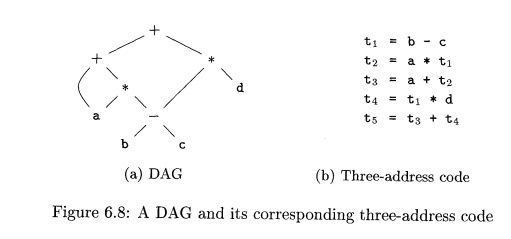
1. Addresses and Instructions
Three-address code is built from two concepts: addresses and
instructions. In object-oriented terms, these concepts correspond to classes,
and the various kinds of addresses and instructions correspond to appropriate
subclasses. Alternatively, three
-address code can be implemented using
records with fields for the addresses; records called quadruples and triples
are discussed briefly in Section 6.2.2.
An address can be one of the following:
• A name. For convenience, we allow
source-program names to appear as addresses
in three-address code. In an implementation, a source name is replaced by a
pointer to its symbol-table entry, where all information about the name is
kept.
• A constant. In practice, a compiler must deal
with many different types of
constants and variables. Type conversions within expressions are con-sidered in
Section 6.5.2.
• A compiler-generated temporary. It is
useful, especially in optimizing com-pilers, to create a distinct name each
time a temporary is needed. These temporaries can be combined, if possible,
when registers are allocated to variables.
We now consider the common three-address
instructions used in the rest of this book. Symbolic labels will be used by
instructions that alter the flow of control. A symbolic label represents the
index of a three-address instruction in the sequence of instructions. Actual
indexes can be substituted for the labels, either by making a separate pass or
by "backpatching," discussed in Section 6.7. Here is a list of the
common three-address instruction forms:
Assignment instructions of the
form x = y op z, where op is a binary arithmetic or logical
operation, and x, y, and z are addresses.
Assignments of the form x = op y, where op is a unary operation. Essen-tial unary operations include unary
minus, logical negation, shift opera-tors, and conversion operators that, for
example, convert an integer to a floating-point number.
3. Copy instructions of the form x = y, where x
is assigned the value of y.
4. An unconditional jump g o t o L.
The three-address instruction with label
L is the next to be executed.
5. Conditional jumps of the form if x
goto L and if F a l s e x goto L. These instructions execute the instruction with label L next if x is true and false, respectively. Otherwise, the following
three-address instruction in sequence is executed next, as usual.
6. Conditional jumps such as if x relop y goto L, which apply a relational operator (<, ==, >=, etc.) to x and y, and execute the instruction with label L next if x stands in
relation relop to y. If not, the three-address instruction
following if x relop y goto L is executed next, in sequence.
7. Procedure calls and returns
are implemented using the following instruc-tions: param x for parameters; c a l l p , n and y = c a l l p , n for procedure and function calls, respectively;
and r e t u r n y, where y,
representing a returned value, is optional. Their typical use is as the sequence
of three-address instructions
generated as part
of a call of the
procedure p(x1,x2, • • • ,xn). The integer n,
indicating the number of actual parameters in " c a l l p,
n," is not redundant because calls
can be nested. That is, some of the first param statements could
be parameters of a call that comes after p returns its value; that value becomes another parameter of the
later call. The implementation of
procedure calls is outlined in Section 6.9.
8. Indexed copy instructions
of the form x = y[il and xlil = y. The instruction x = y lil sets x to the value in the location i memory units beyond
location y. The instruction x[i"]
=y sets the contents of the location i
units beyond x to the value of y.
9. Address and pointer assignments of the form x = &y, x = * y, and
* x - y.
The instruction x = ky sets the
r-value of x to be the location
(/-value) of y? Presumably y is a
name, perhaps a temporary, that
denotes an expression with an /-value such as A[i] [ j ] , and # is
a pointer name or temporary. In the
instruction x = *y,
presumably y is a pointer or a
temporary whose r-value is a location. The r-value of x is made equal to the contents of
that location. Finally, *
x = y sets the r-value of the object
pointed to by x to the r-value of
y.
Example 6 . 5 : Consider the statement
do i = i
+ 1 ; while ( a [ i ] < v ) ;
Two possible translations of this statement are shown in Fig. 6.9. The
transla-tion in Fig. 6.9 uses a symbolic label L, attached to the first
instruction. The translation in (b) shows position
numbers for the instructions, starting arbitrar-ily at position 100. In both
translations, the last instruction is a conditional jump to the first
instruction. The multiplication i * 8 is appropriate for an array of elements that
each take 8 units of space.
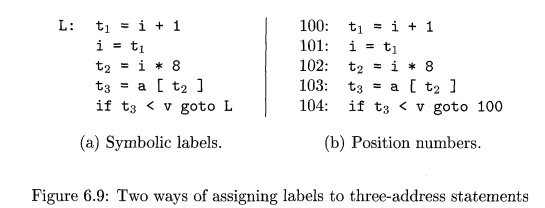
The choice of allowable operators is an important
issue in the design of an intermediate form. The operator set clearly must be
rich enough to implement the operations in the source language. Operators that
are close to machine instructions make it easier to implement the intermediate
form on a target machine. However, if the front end must generate long
sequences of instructions for some source-language operations, then the
optimizer and code generator may have to work harder to rediscover the
structure and generate good code for these operations.
2. Quadruples
The description of three-address instructions
specifies the components of each type of instruction, but it does not specify
the representation of these instruc-tions in a data structure. In a compiler,
these instructions can be implemented as objects or as records with fields for
the operator and the operands. Three such representations are called
"quadruples," "triples," and "indirect triples."
A quadruple
(or just "quad!') has four
fields, which we call op, arg1: arg2, and result. The op field contains an internal code for
the operator. For instance, the three-address instruction x = y + z is represented by placing + in op, y in arg1, z in arg2, and x in result. The following are some exceptions to this rule:
1. Instructions with unary operators like x = minus y or x = y do not
use arg2. Note that for a copy statement like x = y, op is =, while for most
other operations, the assignment operator is implied.
2. Operators like p a r am use neither arg2 nor result.
3. Conditional and unconditional jumps put the target label in result.
Example 6 . 6: Three-address code
for the
assignment a = b * - c + b * - c ; appears in Fig.
6.10(a). The special operator minus is
used to distinguish the unary minus operator, as in - c, from the binary minus
operator, as in b - c. Note that the unary-minus "three-address"
statement has only two addresses, as does the copy statement a = t 5 .
The quadruples in Fig. 6.10(b) implement the three-address code in (a).
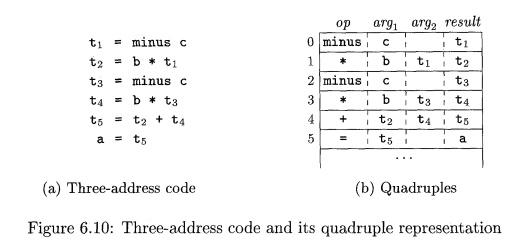
For readability, we use actual
identifiers like a, b, and c in the fields
argx, arg2, and result in Fig. 6.10(b),
instead of pointers to their symbol-table entries. Temporary names can either by entered into the symbol table like
programmer-defined names, or they can be implemented as objects of a class Temp with its own methods.
3. Triples
A triple has only three fields, which we call op, argx, and arg2- Note that the result field in
Fig. 6.10(b) is used primarily for temporary names. Using triples, we refer to
the result of an operation x op y by its position, rather than by an explicit temporary name.
Thus, instead of the temporary ti in Fig. 6.10(b), a triple representation
would refer to position (0). Parenthesized numbers represent pointers into the
triple structure itself. In Section 6.1.2, positions or pointers to positions
were called value numbers.
Triples are equivalent to
signatures in Algorithm 6.3. Hence, the DAG and triple representations of
expressions are equivalent. The equivalence ends with expressions, since
syntax-tree variants and three-address code represent control flow quite
differently.
E x a m p l e 6 . 7 : The syntax
tree and triples in Fig. 6.11 correspond to the three-address code and
quadruples in Fig. 6.10. In the triple representation in Fig. 6.11(b), the copy
statement a = t5 is encoded in the triple representation by placing a in the arc^ field
and (4) in the arg2 field. •
A ternary operation like x[i] = y requires two entries in the triple structure; for example, we can
put x
and i in one triple and y in the next. Similarly, x = y{.%]
can implemented by treating it as if it were the two instructions
Why Do We Need Copy Instructions?
A simple algorithm for translating expressions generates copy
instructions for assignments, as in Fig. 6.10(a), where we copy ts into a rather than assigning t2 +14 to a directly. Each
subexpression typically gets its own, new temporary to hold its result, and
only when the assignment operator = is processed do we learn where to put the
value of the complete expression. A code-optimization pass, perhaps using the
DAG of Section 6.1.1 as an intermediate form, can discover that can be replaced
by a.
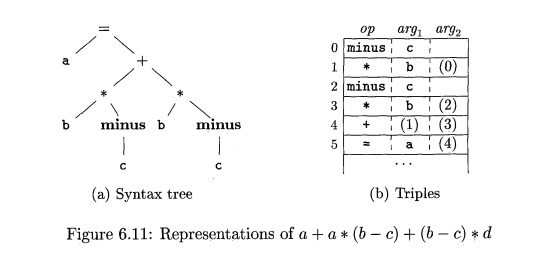
t = y[i] and x = t, where i i s a
compiler-generated temporary. Note that the
temporary t does not actually
appear in a triple, since temporary values are referred to by their position in
the triple structure.
A benefit of quadruples over triples can be seen in
an optimizing compiler, where instructions are often moved around. With
quadruples, if we move an instruction that computes a temporary t, then the instructions that use t require no change. With triples, the
result of an operation is referred to by its position, so moving an instruction
may require us to change all references to that result. This problem does not
occur with indirect triples, which we consider next.
Indirect triples consist of a listing of pointers
to triples, rather than a listing of
triples themselves. For example, let us use an array instruction to list pointers to triples in the desired order. Then,
the triples in Fig. 6.11(b) might be represented as in Fig. 6.12.
With indirect triples, an optimizing compiler can move an instruction by
reordering the instruction list,
without affecting the triples themselves. When implemented in Java, an array of
instruction objects is analogous to an indi-rect triple representation, since
Java treats the array elements as references to objects.
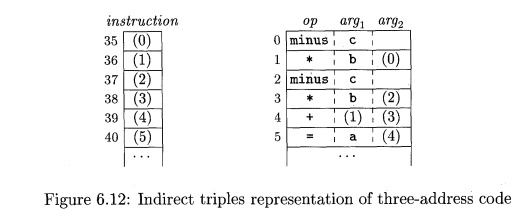
4. Static Single-Assignment Form
Static single-assignment form (SSA) is an intermediate representation
that fa-cilitates certain code optimizations. Two distinctive aspects
distinguish SSA from three-address code. The first is that all assignments in
SSA are to vari-ables with distinct names; hence the term static single-assigment. Figure 6.13 shows the same intermediate
program in three-address code and in static single-assignment form. Note that
subscripts distinguish each definition of variables p and q in the SSA
representation.

The same variable may be defined
in two different control-flow paths in a program. For example, the source
program
if ( f l a g )
x = -1; e l s e x = 1;
y = x * a;
has two control-flow paths in which the variable x
gets defined. If we use different names for x in the true part and the false
part of the conditional statement, then which name should we use in the
assignment y = x * a? Here is where the second distinctive aspect of SSA comes
into play. SSA uses a notational convention called the (^-function to combine
the two definitions of x:
if ( f l a g ) xi = -1; e l s e x2 = 1; x 3 = ϕ ( x 1 , x 2 ) ;
Here, ϕ(x1,x2) has the value x2 if the control flow passes through the
true part of the conditional and the value x2 if the control flow passes
through the false part. That is to say, the ϕ-function returns the value of its
argument that corresponds to the control-flow path that was taken to get to the
assignment-statement containing the ϕ-function.
5. Exercises for Section 6.2
Exercise 6 . 2 . 1 :
Translate the arithmetic expression
a + - (a -b- c) into:
A syntax tree.
Quadruples.
Triples.
Indirect triples.
Exercise
6 . 2 .
2: Repeat Exercise 6.2.1 for the following assignment state-ments:
a
= b[i] +
c[j].
a[i] = b*c
- b*d.
Hi. x = f (y+1) + 2.
x = *p + &y.
Exercise 6 . 2 . 3: Show how
to transform a three-address code sequence into one in
which each defined variable gets a unique variable name.
Related Topics